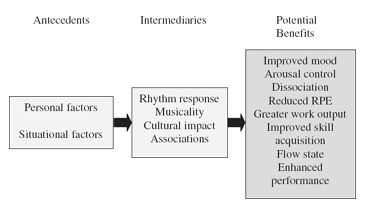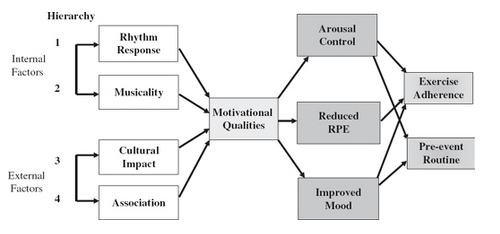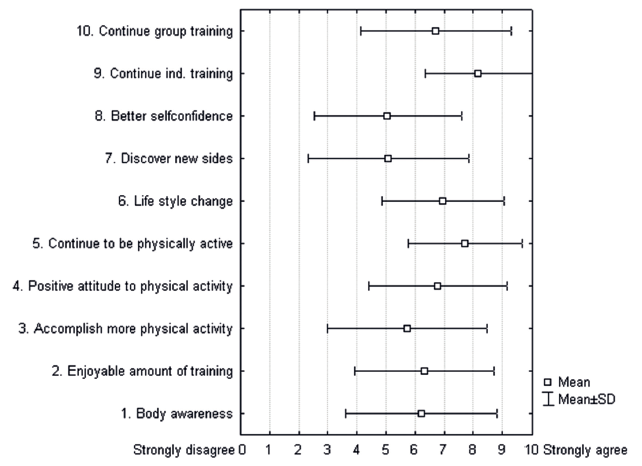Introduction
Fitness instructors are actively involved in the research and practical activities associated with finding the effective methods to improve the exercise behaviour and muscle performance. Music is actively discussed today as an effective method to be used in fitness or physical training and professional sports for enhancing muscle performance and athletes’ results. It is stated in recent researches that music can not only influence the athlete’s emotional state but also affect such physiological processes as the heart rate and respiration (Atkinson, Wilson & Eubank 2004, p. 611; Barwood et al. 2009, p. 435).
As a result, it is important to pay more attention to discussing the role of music heard in fitness rooms and at training grounds. The main purpose of this report is to provide the overview and analysis of the effects of music on the improvement of muscle performance. The report also provides the discussion of the approaches to using the positive connection between music and athletes’ performance in marketing and business environments.
Effects of Music on Enhancing Exercise Performance and Motivation
Music in Stimulating Physiological Processes
Recent researches provide much evidence to support the fact that music affects performance at the physiological level. In spite of the fact that in his research, Atan demonstrates that there no significant changes in anaerobic performance and results associated with performing physical activity while listening to the slow rhythm music or fast rhythm music, the other researchers provide a lot of evidence to state that music can increase the anaerobic performance significantly (Atan 2013, p. 36). Anaerobic and muscle performance are affected by music directly when athletes are focused on rhythm and tempo.
Moreover, the music tempo is often discussed as a main factor to affect changes in performance. According to Szabo and Hoban, fast-tempo music can influence persons’ performance effectively because of increasing the quality of training. The opposite effect has the slow-tempo music (Szabo & Hoban 2004, p. 39). The high music tempo and clear rhythm improve the motor coordination because of the synchronisation processes (Atkinson, Wilson & Eubank 2004, p. 611). Music can affect the exercise performance positively because it influences the brain activity, the speed of reactions, and a range of other neural and physiological processes.
Referring to the specific cardiovascular and respiratory responses to listening to music during the physical activities, it is important to note changes in the breath length and heart rate in 20% and 10%. Thus, the heart rate becomes slow, and respiratory activities stabilise affecting the quality of the exercise performance (Etzel et al. 2006, p. 57). About 60% of physically active sportsmen point at the increases in the oxygen intake during the physical activities. Researchers also observe significant decreases in the heart rate and blood pressure in more than 45% of the survey participants (Paulin, Aasa & Madison 2013, p. 783). Changes in athletes’ respiratory processes and heart rate are directly associated with changes with their muscle performance because of improving endurance performance.
One more positive effect of music on exercise performance is the changes in the focus on fatigue and relaxation processes. Music can be discussed as an important factor to stimulate the positive behavioural change. Listening to music affects the brain activity, and a person’s reactions to stimuli change (Pankseppa & Bernatzky 2002, p. 134). These facts can be used in improving the muscle performance while using music in order to affect the brain processes associated with the person’s attention. Thus, music improves performance in relation to simple motor tasks, reduces ratings of perceived exertion, and improves the energy efficiency.
Music in Affecting Psychological Functioning
In spite of focusing on the role of music for affecting the physiological processes, it is necessary to discuss the primary goal of using music in training which is the improvement of the emotional state. According to Crust, music directly influences the levels of psychological arousal because of associations and stimulating the person’s activity with the help of the melodic structure (Crust 2004, p. 985). Referring to Figure 1, it is possible to note that having a clear rhythmic pattern, cultural background, and provoking associations, music can affect the person’s mood, emotions, feelings, and behaviour

Thus, tempo and rhythm also influence the psychological state of an athlete. Researchers note significant reduction in the feeling of fatigue when high-tempo music is heard (Miller et al. 2010, p. 45). In order to evaluate the effect of music on the athletes’ performance during a 10-km time trial, Atkinson, Wilson, and Eubank assessed the changes in the measures during the period of a trial and asked participants to determine what factors influenced their muscle performance.
It was found that the cycling speed was improved during the first minutes of a trial, and the participants noted that performance improved because of focusing on the music’s tempo and rhythm. Furthermore, music decreased the participants’ fatigue (Atkinson, Wilson, & Eubank 2004, p. 611). As a result, the person’s muscle performance and psychological state improve significantly.
Music as the Motivational Factor
Stimulating changes in the psychological state of a person, music can be discussed as a strong motivational factor. The use of favourite music to accompany training activities improves the exercise performance of different people, in spite of their age, abilities, and gender. The key aspect is the focus on selecting the preferred music for training because the motivational role of music to enhance the muscle performance increases. Furthermore, the results related to the perceived effort decrease while reducing the rates of experienced fatigue (Lin & Lu 2013, p. 389). Referring to Figure 2, it is possible to discuss the motivational quality of music which is observed in increasing the arousal control, perceived effort decrease, and improved mood.

Music in Rehabilitation Process and Working with Motor Behaviour Disorders
Health and fitness professionals refer to using music in their training because of the music effects on working with orthopaedic, neuromuscular disorders, and motor behaviour disturbances. Furthermore, rehabilitation associated with music therapy is also effective for patients with Parkinson’s disease. Music is discussed as the effective rhythmic stimulus to improve persons’ motor skills.
According to Pacchetti and the group of researchers, the effectiveness of adding music to the rehabilitation training and therapy is high, with significance in p <.0001 (Pacchetti et al. 2000, p. 386). Motor improvements and the progress in working with different types of disorders are observed regularly. While listening to the rhythmic music patients with orthopaedic, neuromuscular, and motor disorders are able to perform middle-intensity exercises because of the focus on the synchronization effect.
Music in Stimulating Maximal Muscle Performance
Music is also discussed as a critical factor to stimulate athletes’ maximal muscle performance. Fitness instructors and professional trainers are interested in making sportsmen and clients faster, more active, and more productive. It is stated in many researches that the connection between the use of music and improvement in performance is direct that is why the use of auditory stimuli is prohibited during competition to avoid the provision of the additional advantage. Music can reduce fatigue and increase endurance in 48%, muscle tension also decreases, and the physical strength increases (Nakamura et al. 2010, p. 257). As a result, athletes receive a chance to demonstrate maximal muscle performance.
That is why, the effects of music on maximal muscle performances are researched by many investigators because of the great potential of using music as the additional motivational tool for increasing the performance results. Jarraya and the group of researchers focused on evaluating the ergogenic effects of using music with references to short-term supramaximal exercises and Ppeak and Pmean measures. It was found that the results increased in relation to 4.1 ± 3.6 and 4.0 ± 3.7 W·kg−1 for Ppeak and Pmean measures (Jarraya et al. 2012, p. 234). Thus, it is possible to state that music also affects the supramaximal and maximal performance because of influencing the psychomotor arousal and stimulating activities.
The Effectiveness of Using Music in Professional Training Activities and Fitness Clubs
Music in Professional Training
Music is an important motivational factor which influences the quality of the exercise and the person’s performance. In order to enhance people to use music in their training, it is necessary to demonstrate the advantages of listening to music while doing exercises (Karageorghis & Priest 2012, p. 45). According to Rendi, Szabo, and Szabo, music is an effective tool to increase productivity and stimulate the persons’ activity in both outdoor and indoor sessions (Rendi, Szabo & Szabo 2008, p. 175). Having used music in training sessions, Paulin, Aasa, and Madison asked the participants to record the changes in their attitudes to physical training and to their bodies. It was found that the majority of participants chose to focus on further training (Figure 3; Paulin, Aasa & Madison 2013, p. 790)

Marketing Approaches to Using Music
Athletes and client in fitness clubs demonstrate better results and high motivation to be trained while using players and listening to FM stations because of not focusing on their fatigue and duration of the exercise. This idea is presented in the surveys conducted by Bernatsky and the group of researchers, by Lin and Lu, and by Pankseppa and Bernatzky (Bernatsky et al. 2004, p. 4; Lin & Lu 2013, p. 388; Pankseppa & Bernatzky 2002, p. 133). Understanding that music contributes to increasing the person’s motivation, positive changes in the mood, and improves exercise performance, fitness professionals are focused on promoting the active use of different technological devices in their training activities.
Using personal music players such as iPod or MP3 players, it is possible to select and listen to the music which addresses the subjective preferences and can work effectively to increase the personal results and muscle performance. Today, a variety of small and lightweight personal music players are proposed in the market, and there is the space to expand the market (Barney, Gust & Liguori 2012, p. 23; Crust 2004, p. 985).
More attention should be paid to designing headphones and earbuds which do not prevent the athletes from doing their exercises. Furthermore, the advantages of using music in training are often presented in visuals and video. Many fitness clubs and centres use music to accompany training activities, demonstrate video accompanied with popular audio tracks, and use visuals presenting athletes during their training sessions with players and headphones.
Conclusion
The use of music in training is an important factor to stimulate the increase in muscle performance because music has the complex effect on the athlete’s organism. The first obvious effect is the changes in physiological and neural processes. As a result, persons’ performance improves, and the feeling of fatigue becomes reduced. The next positive effect is the increased motivation. Listening to the preferred music, persons’ mood increases, they try to follow the rhythm of melodies, and the perception of the context of physical activities changes according to associations.
The use of music should be promoted in fitness centres and training clubs because music can stimulate persons to achieve higher results while affecting their maximal performance. Furthermore, professionals in rehabilitation training can also use music in order to stimulate persons’ motor skills. Thus, music affects all the aspects of training positively, and it improves muscle performance significantly. That is why, players and headphones are important parts of the athletes’ equipment during training sessions.
References
Atan, T 2013, ‘Effect of music on anaerobic exercise performance’, Biology of Sport, vol. 20, no. 1, pp. 35–39.
Atkinson, G, Wilson, D & Eubank, M 2004, ‘Effects of music on work-rate distribution during a cycling time trial’, International Journal of Sports Medicine, vol. 25, no. 8, pp. 611-615.
Barney, D, Gust, A & Liguori, G 2012, ‘College Students’ Usage of Personal Music Players (PMP) During Exercise’, Journal of Research in Health, Physical Education, Recreation, Sport & Dance, vol. 7, no. 1, pp. 23-26.
Barwood, M, Weston, N, Thelwell, R & Page, J 2009, ‘A Motivational Music and Video Intervention Improves High-Intensity Exercise Performance’, Journal of Sports Science Medicine, vol. 8, no. 3, pp. 435–442.
Bernatsky, G, Bernatsky, P, Hesse, H-P, Staffen, W & Ladurner, G 2004, ‘Stimulating music increases motor coordination in patients afflicted with Morbus Parkinson’, Neuroscience Letters, vol. 361, no. 1, pp. 4-8.
Crust, L 2004, ‘Carry-over effects of music in an isometric muscular endurance task’, Perceptual Motor Skills, vol. 98, no. 1, pp. 985-991.
Etzel, J, Johnsen, E, Dickerson, E, Tranel, D & Adolphs, R 2006, ‘Cardiovascular and respiratory responses during musical mood induction’, International Journal of Psychophysiology, vol. 61, no. 1, pp. 57-69.
Jarraya, M, Chtourou, H, Aloui, A, Hammouda, O & Chamari, K 2012, ‘The Effects of Music on High-intensity Short-term Exercise in Well Trained Athletes’, Asian Journal of Sports Medicine, vol. 3, no. 4, pp. 233–238.
Karageorghis, C & Priest, D 2012, ‘Music in the exercise domain: a review and synthesis’, International Review of Sport and Exercise Psychology, vol. 5, no. 1, pp. 44-46.
Lin, J & Lu, F 2013, ‘Interactive Effects of Visual and Auditory Intervention on Physical Performance and Perceived Effort’, Journal of Sports Science & Medicine, vol. 12, no. 3, pp. 388–393.
Miller, T, Swank, A, Manire, J, Robertson, R & Wheeler, B 2010, ‘Effect of music and dialog on perception of exertion, enjoyment, and metabolic responses during exercise’, International Journal of Fitness, vol. 6, no. 1, pp. 45-52.
Nakamura, P, Pereira, G, Papini, C, Nakamura, F & Kokubun, E 2010, ‘Effects of preferred and nonpreferred music on continuous cycling exercise performance’, Perceptual and Motor Skills, vol. 110, no. 1, pp. 257-264.
Pacchetti, C, Mancini, F, Aglieri, R, Fundarò, C, & Martignoni, E 2000, ‘Active music therapy in Parkinson’s disease: an integrative method for motor and emotional rehabilitation’, Psychosomatic Medicine, vol. 62, no. 3, pp. 386-393.
Pankseppa, J & Bernatzky, G 2002, ‘Emotional sounds and the brain: the neuro-affective foundations of musical appreciation’, Behavioural Processes, vol. 60, no. 1, pp. 133-155.
Paulin, J, Aasa, U & Madison, G 2013, ‘Physical and psychological effects from supervised music exercise’, American Journal of Health Behavior, vol. 37, no. 6, pp. 780-793.
Rendi, M, Szabo, A & Szabo, T 2008, ‘Performance enhancement with music in rowing spring’, The Sport Psychologist, vol. 22, no. 1, pp. 175-182.
Szabo, A & Hoban, L 2004, ‘Psychological effects of fast-and slow-tempo music played during volleyball training in a national league team’, International Journal of Applied Sport Science, vol. 16, no. 1, pp. 39-48.